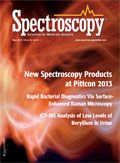Appendix II: Atomic Spectroscopy
Additional information from the atomic spectroscopy section of the Pittcon Review article.
Manufacturer: Applied Spectra, Inc.
Product name: J200
Tandem LIBS-LA Instrument - LA system for LA-ICP-MS, LIBS (Laser Induced Breakdown Spectroscopy) Instrument
New this year: The J200 Tandem enables simultaneous LA-ICP-MS and LIBS
Special Features: Uses laser ablation to enable direct solid sample analysis by generating tiny particles from your samples and transporting them to your ICP-MS instrument. The J200 Tandem uses the same laser ablation to produce a tiny micro-plasma and to capture emitted light for emission spectroscopic analysis. This tandem LA – LIBS capability enables the ability to measure specific isotopes and simultaneously obtain quantitative or qualitative analysis of major, minor and trace elements.
Compatible with quadrupole-, TOF-, and ICP-MS instruments from major manufacturers.
Suggested applications: Major/minor & trace elemental analysis for metal, mining, forensic, nuclear, & environmental industries, Isotopic analysis for geochemistry application.
Primary benefits: High precision ICP-MS isotopic measurement, concentration range from percent down to ppb, organic and lighter elements, sampling methods include bulk, inclusion, depth profiling, and elemental mapping
Unique features: Simultaneous LA-ICP-MS and LIBS measurement capability
Brooks-Rand Instruments
Product name: MERX
Mercury Analyzer
New this year: Modular system capable of testing for mercury based upon US EPA methods 245.7, 1630 and 1631
Used for: Lab analysis
Measurement Mode: Atomic fluorescence
Special Features: modular design eliminates the need for multiple mercury analyzers
Software: instrument control software is included
Suggested applications: water, sediments, biological tissue, blood, urine
Primary benefits: capable of performing total and methyl mercury analysis. Samples are purged in the vial, eliminating the need for peristaltic pumps and liquid separators.
Unique features: Completely sealed system, Less waste, lower operating cost, Longer reaction times, more reliable results, Separate sample lines to reduce contamination, Easier maintenance, Modular design
Manufacturer: Bruker
Product name: Aurora Elite
ICP-MS
New this year: Improved performance
Used for: Lab, Process, Hand-held/portable operation
Measurement Mode: MS
Features: 1.5 GHz/ppm sensitivity, Lowest oxide ratios, 100 μs integration times, interference management.
Software: Comes complete with proprietary Quantum software for user access control, permissions, audit logging, data security. 21CFR11 compliant, cGMP compliant, may be used in other equipment, Compatible with other manufacturers' equipment
Suggested applications: Environmental, food safety, water testing, semiconductor, geochemistry, nanoparticles, materials science, pharmaceutical
Primary benefits: precise and accurate quantification of 1.5 GHz/ppm:
Unique features: Aurora Elite is the most sensitive ICP-MS instrument currently on the market
Manufacturer: Milestone, Inc
Product name: FMA-80
Mercury analyzer, atomic absorption and atomic Fluorescence spectrometer
New this year: Simultaneous atomic absorption and atomic fluorescence
Used for: Lab analysis
Available as separate product, 21CFR compliant
Suggested applications: water, digested samples
Primary benefits: High sample throughput, automation, wide detection range
Unique features: One valve system, Special PVC tubing, auto blank feature
Manufacturer: Nippon Instruments Corporation – Japan
Product name: Model RA-4500 Automated Mercury Analyzer
Atomic absorption Spectrometer: Dedicated Mercury Analyzer
New this year: Full automation of the sample digestion and analysis without any user intervention.
Used for: Lab analysis
Measurement Mode: Atomic Absorption
Special Features: Full automation of sample prep and analysis. cGMP compliant
Suggested applications: waters, wastewaters, blood, urine, and other solutions
Primary benefits: Increased productivity through automation of sample preparation and seamless transfer to analysis, reduces wastes by over 90%, significant labor and operation costs reduction.
Unique features: Full automation that follows EPA and other methods. NIST-traceable temperature logging for digestion.
Manufacturer: TSI Incorporated
Product name: ChemReveal
New this year: LIBS Desktop Analyzer
New this year: software providing easier quantification and calibration, higher precision spatial analysis, smaller size, faster sample screening, improved long-term stability
Used for: Lab analysis
Measurement Mode: Laser-induced breakdown spectroscopy (LIBS)
Software: Proprietary ChemLyticsNew this year: software
Available as separate product
Suggested applications: metals, pharmaceuticals, geochemical, environmental, gemology, forensics, elemental impurities in pharmaceuticals; Pb, Cd, and Cr in electronics, jewelry, and toys; drill-core samples; Carbon nanotube impurity analysis, alloy composition; Tablet coating surface uniformity; Particle loaded filters; Heat value, ash and sulfur in coal; trace and minor elements in glass, Steel and Stainless Steel; elemental analysis in ores and geological samples; forensics; Rare-Earth Elements, contaminated soils; Thin filmsd, Battery Manufacturing, nutritive balance of soils; Inclusions
Primary benefits: direct, fast, multi-elemental and chemical analysis of solids, no sample preparation.
Unique features: confluence of direct analysis, elemental range, and matrix compatibility. Two sets of cameras.

New Study Reveals Insights into Phenol’s Behavior in Ice
April 16th 2025A new study published in Spectrochimica Acta Part A by Dominik Heger and colleagues at Masaryk University reveals that phenol's photophysical properties change significantly when frozen, potentially enabling its breakdown by sunlight in icy environments.